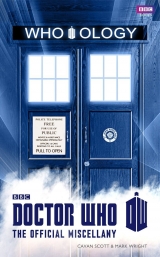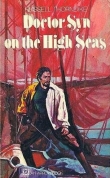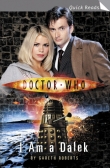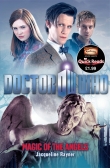
Текст книги "Doctor Who: Who-ology (Dr Who)"
Автор книги: Scott Cavan
Жанры:
Классическое фэнтези
,сообщить о нарушении
Текущая страница: 3 (всего у книги 15 страниц)

Two years later, Baker starred opposite Anthony Hopkins in the acclaimed War and Peace, playing Anatole Kuragin. It was his casting in 1974 as Paul Merroney in the popular BBC drama The Brothers that gave Baker long-lasting TV notoriety. His villainous turn as the ruthless businessman made him a star, with the character voted the most hated man in Britain.
Baker’s reputation for playing villains led to the space pirate Bayban the Butcher in a 1980 episode of Blake’s 7. In 1983 he became the only actor to appear as a different character in Doctor Who on television prior to being cast as the Doctor. The arch Commander Maxil in Arc of Infinity led in turn to his casting as the Sixth Doctor when Peter Davison left the role. Baker’s sharp wit kept guests entertained at a wedding attended by members of the Doctor Who production team, including producer John Nathan-Turner, who knew he’d found his Doctor.
The colourful sixth incarnation of the Time Lord made his debut in 1984. Baker played the Doctor for three years, and has remained connected to the series through regular convention appearances and as a mainstay of Big Finish’s Doctor Who audio adventures. He is a regular face on British television, with credits in Jonathan Creek, Casualty and Hustle adding to his lengthy CV and, following on from his success in Come Dine With Me in 2011, he took part in the ITV reality show I’m a Celebrity… Get Me Out Of Here! in 2012. He works extensively in the theatre, and writes a regular column for his local newspaper, the Bucks Free Press.
 SYLVESTER McCOY – THE SEVENTH DOCTOR
SYLVESTER McCOY – THE SEVENTH DOCTOR
Full Name: Percy James Patrick Kent-Smith
Born: 20 August 1943
First Screen Appearance: Vision On
First regular Doctor Who appearance: Time and the Rani Part 1 (1987)
Final regular Doctor Who appearance: Doctor Who (1996)

Like Tom Baker before him, Sylvester McCoy toyed with following a religious life by training as a priest, but swapped this for an insurance job, before working in the box office of the Roundhouse in London. Here he was spotted by the visionary theatre director and actor Ken Campbell, who invited him to join his performing troupe, the Ken Campbell Roadshow.
McCoy created the character of stuntman Sylveste McCoy during his time with Campbell, famous for slapstick routines that involved ferrets and hammering nails up his nose. An ‘r’ was later added to the name, providing Percy Kent-Smith with his more familiar stage name.
McCoy’s mastery of physical comedy led to his working relationship with producer Clive Doig, who employed him on shows ranging from Vision On to Jigsaw. Doig was instrumental in McCoy’s casting as the Seventh Doctor after phoning producer John Nathan-Turner to recommend his friend as the ideal successor to Colin Baker. Following several screen tests, McCoy was offered the role.
McCoy remained with Doctor Who until it ceased production in 1989, returning happily in 1996 to hand over the TARDIS keys to Paul McGann, filming several sequences, including a regeneration scene, in the Doctor Who TV movie filmed in Canada. He now appears regularly in the Doctor Who audio dramas produced by Big Finish.
Work following Doctor Who has seen McCoy appear regularly on stage, screen and radio. In 2007 he appeared as the Fool opposite Ian McKellen in an RSC production of King Lear. Four years later he would join McKellen in New Zealand to play Radagast in a three-part film adaptation of The Hobbit.
 PAUL McGANN – THE EIGHTH DOCTOR
PAUL McGANN – THE EIGHTH DOCTOR
Full Name: Paul McGann
Born: 14 November 1959, Liverpool
First Screen Appearance: Play for Today: Whistling Wally (TV, 1982)
Doctor Who appearance: Doctor Who (1996)
As one-quarter of the McGann acting brotherhood (along with Joe, Mark and Stephen), Paul McGann was considered one of Britain’s most exciting young actors following his graduation from RADA in the early 1980s. His breakthrough role was opposite Robert Lindsay in the comedy drama Give Us a Break in 1983, but two subsequent roles would seal his reputation as a star to watch.

In 1986 he was BAFTA-nominated for his acclaimed performance as Percy Toplis in the BBC’s controversial First World War drama The Monocled Mutineer, and he earned a cult following for his turn as ‘I’ in the comedy film Withnail and I in 1987 with Richard E. Grant.
Roles in Hollywood movies Alien 3 and The Three Musketeers followed in the early 1990s, then in 1993 he was cast as Richard Sharpe in a TV adaptation of Bernard Cornwall’s Sharpe novels – a role he was forced to abandon after injuring his knee playing football just weeks into the shoot. His next major casting would see him travel to Canada in 1996 to become the eighth incarnation of the Doctor in a TV movie that was intended to relaunch Doctor Who for an international audience. McGann sought the advice of his friend Sylvester McCoy, who encouraged him to take the role, and the two soon found themselves filming a regeneration scene in an abandoned hospital in Vancouver.
While McGann’s screentime is the briefest of all eleven Doctors – the TV movie failed to secure a commission for a full series – McGann has recorded numerous audio dramas as the Eighth Doctor. He continues to record new stories, and appears regularly at conventions.
McGann is never away from TV screens for long. He starred in the BBC drama Fish in 2000 and played Lieutenant Bush in the second series of Hornblower shortly after. Recent television work has included New Tricks, Luther and Ripper Street.
 CHRISTOPHER ECCLESTON – THE NINTH DOCTOR
CHRISTOPHER ECCLESTON – THE NINTH DOCTOR
Full Name: Christopher Eccleston
Born: 16 February 1964, Salford
First Screen Appearance: Blood Rights (TV, 1990)
First regular Doctor Who appearance: Rose (2005)
Final regular Doctor Who appearance: The Parting of the Ways (2005) Christopher Eccleston grew up in Salford, Lancashire, and harboured dreams of playing football for Manchester United until it was clear his talent lay with acting. He trained at the Central School of Speech and Drama and made his stage debut in a production of A Streetcar Named Desire at the Bristol Old Vic in 1988. More stage work followed, but film and TV proved elusive.

Eccleston’s breakthrough screen role was as Derek Bentley in the film Let Him Have It (1991), but it was his performance as DCI Billborough in Cracker (1993) that really brought him to the attention of TV audiences. Eccleston has combined film, TV and stage work throughout his career. He played Trevor Hicks in Jimmy McGovern’s Hillsborough, and was BAFTA-nominated in 1997 for his work in the critically acclaimed drama Our Friends in the North. Film work, on both sides of the Atlantic, includes Elizabeth (1998), Gone in 60 Seconds (2000) and 28 Days Later (2002).
In 2003, Eccleston played Stephen Baxter in The Second Coming and, shortly after, the actor emailed the drama’s writer, Russell T Davies. Davies was working on a new series of Doctor Who for the BBC, and Eccleston was keen to be considered for the part of the Doctor. A few months later it was confirmed that Christopher Eccleston would be the ninth actor to play the Doctor.
Eccleston left Doctor Who after one series, saying he had done what he wanted to do with the part. Like William Hartnell over 40 years previously, he had redefined his career away from weighty roles to become a hero for a new generation of children.
Christopher Eccleston has maintained his exhausting work schedule since leaving Doctor Who, guest-starring in the US drama series Heroes, BBC crime thriller The Shadow Line and films The Dark is Rising (2007) and G.I. Joe: The Rise of Cobra (2009) and as villain Malekith in superhero sequel Thor: The Dark World (2013).
Like the Eighth Doctor before him, the Earth-loving Ninth never had a televised story set on an alien world.
 DAVID TENNANT – THE TENTH DOCTOR
DAVID TENNANT – THE TENTH DOCTOR
Full Name: David John McDonald
Born: 18 April 1971
First Screen Appearance: Dramarama: The Secret of Croft more (TV, 1988)
First regular Doctor Who appearance: The Parting of the Ways (2005)
Final regular Doctor Who appearance: The End of Time, Part Two (2010)

When he grew up, young David McDonald told his parents, he wanted to be an actor because he was a big fan of Doctor Who. Over 30 years later, not only would he have achieved his dream and become an actor – he would also be the Doctor!
At the age of 16, Tennant would be one of the youngest students to be accepted by the Royal Scottish Academy of Music and Drama. Following graduation, he appeared in several productions for the 7:84 Theatre Company, and appeared in TV sitcom Rab C Nesbitt in 1993. Tennant’s first major TV role was as manic depressive Campbell in Takin’ Over the Asylum (1994) with Ken Stott, and he would continue to work steadily throughout the 1990s, combining TV and theatre work.
Film roles included Jude (with Christopher Eccleston) in 1996 and Bright Young Things (2003), while television took in Randall & Hopkirk (Deceased), People Like Us and Blackpool. In 2005 he was cast as the young Casanova in a major BBC production, written by Russell T Davies, who was also working on the first series of Doctor Who. When Christopher Eccleston left the series, Davies immediately turned to his Casanova and offered Tennant the chance to play the Tenth Doctor. Tennant’s reaction was to laugh – then ask if he could have a long coat.
Tennant’s time aboard the TARDIS would see Doctor Who as popular as ever with audiences, and he claimed it was a difficult decision to leave the programme after four years – a decision he announced to a live TV audience during the interval while performing Hamlet for the Royal Shakespeare Company.
Tennant has worked on both sides of the Atlantic since leaving Doctor Who, starring in St Trinians 2 (2009), Fright Night (2011) and Nativity 2 (2012), and on television in Single Father, United and Broadchurch. In 2011, Tennant married Georgia Moffett, who had guest-starred in the episode The Doctor’s Daughter. Moffett is the daughter of Peter Davison, making the Fifth Doctor the Tenth Doctor’s father-in-law!
The Tenth Doctor has a surprising claim to fame. This incarnation boasts the most stories set in the future. But hang on, what about all those stories set on present-day Earth? Well, thanks to the events of Aliens of London, they all take place about 12 months in the future.
 MATT SMITH – THE ELEVENTH DOCTOR
MATT SMITH – THE ELEVENTH DOCTOR
Full Name: Matthew Robert Smith
Born: 28 October 1982, Northampton
First Screen Appearance: The Ruby in the Smoke (TV, 2006)
First regular Doctor Who appearance: The End of Time, Part Two (2010)
Final regular Doctor Who appearance: Who knows?

Matt Smith wanted to be a professional footballer, but a back injury forced him to rethink his career choice. He was encouraged by his drama teacher to attend the National Youth Theatre, where he was seen performing by former Doctor Who companion Wendy Padbury – at that time a theatrical agent. She was impressed by Smith’s natural ability, and sent him for an audition at the Royal Court theatre, an audition in which he was successful.
His first TV work had another Doctor Who connection when he played Jim Taylor alongside former companion Billie Piper in The Ruby in the Smoke (2006). More stage work followed, and Smith received an Olivier Award nomination for his celebrated performance in That Face, once again at the Royal Court. He worked with Billie Piper again in an episode of Secret Diary of a Call Girl, and 2007 saw Smith take on his biggest TV role as Danny Foster in Party Animals.
On 3 January 2009, Matt Smith was revealed to the nation as the new Doctor in a special edition of Doctor Who Confidential. It would be nearly a year before he made his brief Doctor Who debut on 1 January 2010, and another three months before the Eleventh Doctor would declare that bow ties are cool in The Eleventh Hour.
Even with Doctor Who taking up much of the year to film, Smith has managed to take on other projects between series, for example filming the dramas Christopher and His Kind in 2011 and Bert and Dickie in 2012.

WHAT’S IN A NAME?
According to Dorium Maldovar, the question that must never be answered is ‘Doctor Who?’ While we’ve never learnt the Doctor’s real name in 50 years, he’s adopted a lot of monikers, both on TV and beyond.
NAMES THE DOCTOR CALLS HIMSELF
The Caretaker – an alias he adopted while looking after the Arwell Family in 1947. (The Doctor, the Widow and the Wardobe)
Doctor Caligari – the alias the First Doctor used while visiting Tombstone, USA in 1881. (The Gunfighters)
Get Off This Planet – a name the Doctor claims he’s often called, although he instantly acknowledges that it probably isn’t a name, strictly speaking. (The Doctor, the Widow and the Wardrobe)
Captain Troy Handsome of International Rescue – when talking to the hologram of a crashed time ship in Colchester. (The Lodger)
Doctor James Macrimmon – how the Doctor introduced himself to Queen Victoria in 1879. (Tooth and Claw)
The King of Okay – A title the Doctor soon dismissed as rubbish. (The Impossible Astronaut)
Bad Penny – apparently the Doctor’s middle name. (The God Complex)
Maximus Pettulian – the Doctor assumed the identity of a murdered lute player while visiting the court of Emperor Nero. (The Romans)
Merlin – an identity yet to be adopted by a future incarnation of the Doctor. (Battlefield)
Doctor Noble of the Noble Corporation – while investigating suspicious goings on at Ood Industries. (Planet of the Ood)
John Smith – various (see ‘John Who?’)
Spartacus – the Doctor called himself Spartacus while visiting Pompeii in AD 79, as did Donna in a tongue-in-cheek reference to the 1960 film of the same name. (Fires of Pompeii)
Doctor Vile of the Mantasphid – the Doctor pretends to be a Pirate Master to try and avoid a war between humans and a race of insectoid aliens. (The Infinite Quest)
Doctor von Wer – the name the Doctor adopted in 1746 during a visit to Inverness, Scotland. Translated from German it means ‘Doctor of Who’. (The Highlanders)
NAMES OTHER PEOPLE HAVE GIVEN THE DOCTOR
Sir Doctor of TARDIS – by Royal Appointment of her Majesty, Queen Victoria. (Tooth and Claw)
Doctor Bowman – an alias adopted to get access to Professor Wagg’s Atomic Clock on 31 December 1999. (Doctor Who)
Caesar – by a Roman, but only because he was under the thrall of River Song’s Hallucinogenic lipstick. (The Pandorica Opens)
The Evil One – used by the Tribe of the Sevateem, unaware that the terrible god they worshipped was a supercomputer which had taken the Doctor’s face. Identity theft taken to the extreme, that. (Face of Evil)
John Doe – on the name tag tied to the Seventh Doctor’s toe after his ‘death’ in San Francisco. (Doctor Who)
Doctor Foreman – mistakenly used by Ian Chesterton on their first meeting. (An Unearthly Child)
The Great Exterminator – how the Emperor Dalek addresses the Doctor. (The Parting of the Ways)
The Destroyer of Worlds – a title Davros used to describe the Doctor. (Journey’s End)
The Old One – according to Balazar, reader of the Books of Knowledge on Ravolox, much to the Doctor’s chagrin. (The Trial of a Time Lord)
The Oncoming Storm – one of the Daleks’ many names for their arch-enemy. (The Parting of the Ways)
The Predator – those Daleks really were petrified of the Doctor. (Asylum of the Daleks)
Prisoner 177781 – the designation given to the Doctor when he was arrested for looting during the evacuation of London. (Invasion of the Dinosaurs)
The Great Wizard Quiquaequod – a mystical moniker given by white witch Olive Hawthorne. (The Daemons)
Raggedy Man – Amy Pond’s nickname for the Eleventh Doctor. Also, the Raggedy Doctor. (Various)
Mr Spock – How Rose Tyler first introduces the Time Lord to Captain Jack Harkness. (The Empty Child)
Sweetie – River Song’s pet-name for her hubby. (From Silence in the Library)
Theta Sigma – The Doctor’s nickname while at the Academy. (The Armageddon Factor, The Happiness Patrol)
The Traveller from Beyond Time – how the Doctor is greeted by the Elders of the far future. (The Savages)
The Watcher – how the Doctor’s companions described his spectral future self. (Logopolis)
Doctor Who – by super computer WOTAN. (Also see ‘Doctor Who?’) (The War Machines)
Zeus – the First Doctor was mistaken for the Greek god by Achilles c.1200 BC (The Myth Makers)
ALL IN A TITLE
The Doctor has no problem adopting or being given titles as well as names. In his time he’s been an Examiner (twice – Power of the Daleks, The War Games), Chairman Delegate from Earth (The Curse of Peladon) and an Ajak (The Sun Makers).

JOHN WHO?
Just as Earth is the Doctor’s favourite planet, John Smith is his favourite alias. Here are just some of the many times he’s used it on his travels:
The First Doctor used it on his Shoreditch library card. (The Vampires of Venice)

The Second Doctor was introduced as John Smith on Space Station W3 – although in this case it was Jamie who gave him the nom de plume (The Wheel in Space). The Doctor had picked up the habit by the time of The War Games.
When asked his name at the end of Spearhead from Space, the Third Doctor replies (in typically Bondian fashion): ‘Smith. Doctor John Smith.’ In The Time Warrior, the Doctor introduces himself as John Smith to fellow scientist Professor Rubeish.
When filling out his hospital forms, the Seventh Doctor was given the name John Smith by Chang Lee. Coincidence? Probably, unless you’re one of those humans who always see patterns in things that aren’t there. (Doctor Who)
The psychic paper introduced the Ninth Doctor as Dr John Smith from the Ministry of Asteroids in The Empty Child.
The Tenth Doctor was particularly fond of the alias. He first used it signing on as a science teacher by the name of John Smith at Deffry Vale High School (School Reunion). He would later use it while pretending to be a patient at Royal Hope Hospital (Smith and Jones), posing as a health and safety officer investigating Adipose Industries (Partners in Crime) and impersonating a policeman (The Unicorn and the Wasp).
Unfortunately, the Tenth Doctor would come unstuck on an ill-fated bus trip on the planet Midnight. When he gave the name, his fellow passengers immediately recognised it as false. Luckily neither the memory-wiped Donna Noble (Journey’s End) nor Jackson Lake (The Next Doctor) had problems swallowing the alias.
The Doctor literally became John Smith – and a human to boot – when hiding from the Family of Blood in England, 1913 (Human Nature, The Family of Blood).
The name came in handy for the Ganger Doctor in The Almost People.
THE TIME LORD OATH
‘I swear to protect the ancient law of Gallifrey with all my might and main and will to the end of my days with justice and with honour temper my actions and my thoughts.’
Time Academy Induction Ceremony (Shada)

THE DOCTOR’S HEIGHT
Just how tall are each of the Doctor’s incarnations?


WHO GOES THERE
Sometimes you need more than barefaced cheek or psychic paper to get by in the universe. Here are just a number of the many disguises employed by our devious Doctor…
A regional officer of the Provinces (The Reign of Terror)
The Monk (The Time Meddler)
Zephon (The Daleks’ Master Plan)
A Redcoat (The Highlanders)
A washerwoman (The Highlanders)
A German doctor (The Highlanders)
A gypsy (The Underwater Menace)
Salamander (The Enemy of the World)
The Karkus (The Mind Robber)
An alien student (The War Games)
A British soldier (The War Games)
A technician (Inferno)
A Dalek (Frontier in Space)
A Spiridon (Planet of the Daleks)
A milkman (The Green Death)
A cleaning lady (The Green Death)
A medieval monk (The Time Warrior)
A robot knight (The Time Warrior)
A Thal guard (Genesis of the Daleks)
A robot mummy (Pyramids of Mars)
Himself – well, his android double at least (The Android Invasion)
Harrison Chase’s driver (The Seeds of Doom)
Hieronymous (The Masque of Mandragora)
A fellow Time Lord (The Deadly Assassin)
A soldier in the Graff Vynda-K’s personal guard (The Ribos Operation)
Meglos (Meglos)
A Sea Base guard (Warriors of the Deep)
A miner (The Mark of the Rani)
A waiter (Rose, Rise of the Cybermen)
A Roboform (The Runaway Bride)
John Smith (Human Nature, Family of Blood)
A Headless Monk (A Good Man Goes to War)
Sherlock Holmes (The Snowmen)
A Punch and Judy man (The Snowmen)


DOCTOR DOUBLES
The Doctor may be a unique individual but doubles of the great man turn up with alarming regularity.
 The robot Doctor (The Chase)
The robot Doctor (The Chase)
Created by the Daleks to ‘infiltrate and kill’ the Doctor and his companions. This was the only Doctor double not to be played by the actor playing the Doctor himself. The robot Doctor was played by Edmund Warwick, who had previously been a stand-in for William Hartnell in The Dalek Invasion of Earth after the lead actor had injured himself. Hartnell did, however, dub the robot Doctor’s lines, as well as appearing in close-ups.
 The Abbot of Amboise (The Massacre of St Bartholomew’s Eve)
The Abbot of Amboise (The Massacre of St Bartholomew’s Eve)
By cosmic coincidence, the anti-Huguenot Abbot of Amboise was a double of the First Doctor. The resemblance was so striking that Steven believed the holy man was the Doctor in disguise.
 Salamander (The Enemy of the World)
Salamander (The Enemy of the World)
Mexican dictator Salamander bore a close resemblance to the Second Doctor – so much so that Time Lord and despot could easily impersonate each other.
 The android Fourth Doctor (The Android Invasion)
The android Fourth Doctor (The Android Invasion)
One of the many pod-produced androids used by the Kraals in their invasion of Earth. So good that even the bad guys couldn’t tell the difference between the fake Doctor and the real deal.
 The carbon-based imprint Doctor (The Invisible Enemy)
The carbon-based imprint Doctor (The Invisible Enemy)
The Doctor duplicated himself – and Leela – so that his double could be shrunk to microscopic size using the TARDIS’s dimensional stabiliser and injected into his own body to combat the Nucleus of the Swarm.
 An army of Doctors (The Leisure Hive)
An army of Doctors (The Leisure Hive)
The Doctor tricked Pangol into creating an army of Doctor clones using the Tachyon Recreation Generator.
 Meglos (Meglos)
Meglos (Meglos)
Using the body of an abducted human, megalomaniac space-cactus Meglos impersonated the Doctor – even when he started sprouting spikes.
 Omega (Arc of Infinity)
Omega (Arc of Infinity)
The Gallifreyan temporal engineer based his new body on the Fifth Doctor.
 Kamelion (The King’s Demons)
Kamelion (The King’s Demons)
The shape-shifting android briefly took on the Time Lord’s form.
 The duplicate Fifth Doctor (Resurrection of the Daleks)
The duplicate Fifth Doctor (Resurrection of the Daleks)
A duplicate created by the Daleks in order to assassinate the High Council of Time Lords.
 The android Fifth Doctor (The Caves of Androzani)
The android Fifth Doctor (The Caves of Androzani)
A robot double created by Sharaz Jek to face General Chellak’s firing squad.
 The Other Doctor (Journey’s End)
The Other Doctor (Journey’s End)
Grown out of the Doctor’s severed hand by means of an instantaneous biological metacrisis.
 The Ganger Doctor (The Rebel Flesh/The Almost People)
The Ganger Doctor (The Rebel Flesh/The Almost People)
Accidentally created when the Doctor touched a vat of living programmable matter the Flesh during a solar storm on 22nd-century Earth.
 The Teselecta Doctor (The Impossible Astronaut, The Wedding of River Song)
The Teselecta Doctor (The Impossible Astronaut, The Wedding of River Song)
Justice Department Vehicle Number 6018 impersonated the Doctor so that he could be murdered by River Song on the shores of Lake Silencio and restore established history.

DOCTOR… WHO?
‘Doctor Who is required.’
WOTAN, The War Machines
The programme is called Doctor Who while the character is just ‘the Doctor’. That hasn’t stopped the name of the show popping up. A lot.








